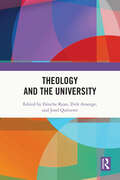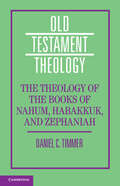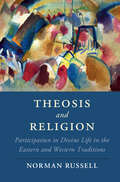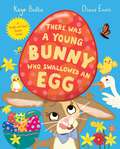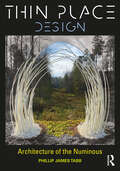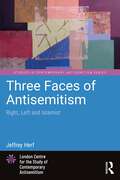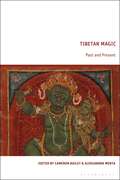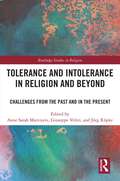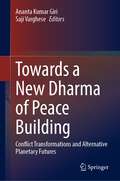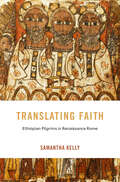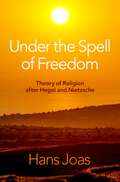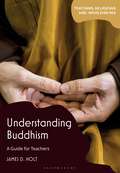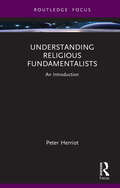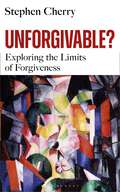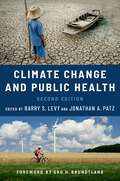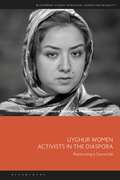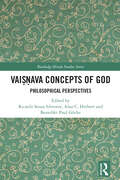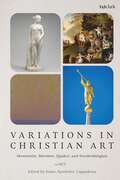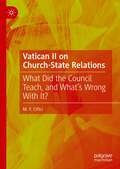- Table View
- List View
Theology and the University
Theology and the University presents a compelling argument as to why theology still matters. It considers how theology has been marginalised in the academy and in public life, arguing that doing so has serious repercussions for the integrity of the academic study of religion.The chapters in this book demonstrate how theology, as the only discipline which represents religion from within, provides insight into aspects of religion which are hidden from the social sciences. Against a backdrop of heated debates on the role of the humanities in the university, the book highlights the specific contribution of theological education and research to the work of a university, providing essential information for academic and social/political decision-making. Whilst the book has an emphasis on the Catholic tradition, it explores the prospect of fruitful complementarity and interdisciplinarity both with secularised studies of religion, and other disciplines in the university, such as literature, philosophy, and the social sciences.This book provides orientation for decision-makers, particularly those concerned with the broader question of humanities in the university; students in their choice of study; those interested in the wellbeing of today’s universities; and ecclesial authorities seeking to form leaders capable of intelligent responses to the issues of contemporary society. It is a must read for all researchers of theology, as well as anyone interested in the role of the humanities more broadly.
The Theology of the Books of Nahum, Habakkuk, and Zephaniah (Old Testament Theology)
by null Daniel C. TimmerThe books of Nahum, Habakkuk, and Zephaniah address problems in and around ancient Judah in ways that are as incisive and critical as they are optimistic and constructive. Daniel C. Timmer's The Theology of the Books of Nahum, Habakkuk, and Zephaniah situates these books in their social and political contexts, examining the unique theology of each as it engages thorny problems in Judah and beyond. In dialogue with recent scholarship, this study focuses on these books' analysis and evaluation of the world as it is, focusing on both human beings and their actions, and God's commitment to purify, restore, and perfect the world. Timmer also surveys these books' later theological use and cultural reception. His study brings their theology into dialogue with concerns as varied as ecology, nationalism, and widespread injustice. It highlights the enduring significance of divine justice and grace for solid hope and effective service in our world.
Theosis and Religion: Participation in Divine Life in the Eastern and Western Traditions (Cambridge Studies in Religion, Philosophy, and Society)
by null Norman RussellTheosis, originally a Greek term for Christian divinisation or deification, has become a vogue word in modern theology. Although recent publications have explored its meaning in a selection of different contexts, this is the first book to offer a coherent narrative of how the concept of theosis developed in both its Eastern and Western versions. Norman Russell shows how the role of Dionysius the Areopagite was pivotal, not only in Byzantium but also in the late mediaeval West, where it strengthened the turn towards an individualistic interiority. Russell also relates theosis to changing concepts of religion in the modern age. He investigates the Russian version of theosis, introduced in the West by Russian members the Paris School after the 1917 Revolution. Since then, theosis has undergone additional development through the addition of esoteric elements which have since passed into the mainstream of all theological traditions and even into popular spirituality.
There Was a Young Bunny Who Swallowed an Egg: A laugh out loud Easter treat!
by Kaye BaillieA laugh-out-loud Easter eggstravaganza, There Was a Young Bunny who Swallowed an Egg from Kaye Baillie and award-winning illustrator Diane Ewen is the perfect springtime story for little ones!Everyone's heard about the old lady who swallowed a fly, but now it’s time to meet a little bunny who, just as the Easter Egg Hunt is starting, swallows . . . an egg! And she doesn't stop there! Soon she's gobbled down a chick, a hot-cross bun, and a basket! What will she gobble down next?A funny, cumulative rhyming story young children will love, packed with Easter chicks, eggs, buns, bees, and one very hungry little bunny – keep an eye on your chocolate eggs!
Thin Place Design: Architecture of the Numinous
by Phillip James TabbWhat makes the places we inhabit extraordinary? Why are some urban spaces more vital and restorative? Wonderful landscapes, inspiring works of architecture and urban design, and the numinous experiences that accompany them have been an integral dimension of our culture. Up-lifting spaces, dramatic use of natural light, harmonic proportional geometry, magical landscapes, historic sites and vital city centers create special, even sacred moments in architecture and planning. This quality of experience is often seen as an aesthetic purpose intended to inspire, ennoble, ensoul and spiritually renew. Architecture and urban spaces, functioning in this way, are considered to be thin places.
Thin Place Design: Architecture of the Numinous
by Phillip James TabbWhat makes the places we inhabit extraordinary? Why are some urban spaces more vital and restorative? Wonderful landscapes, inspiring works of architecture and urban design, and the numinous experiences that accompany them have been an integral dimension of our culture. Up-lifting spaces, dramatic use of natural light, harmonic proportional geometry, magical landscapes, historic sites and vital city centers create special, even sacred moments in architecture and planning. This quality of experience is often seen as an aesthetic purpose intended to inspire, ennoble, ensoul and spiritually renew. Architecture and urban spaces, functioning in this way, are considered to be thin places.
Three Faces of Antisemitism: Right, Left and Islamist (Studies in Contemporary Antisemitism)
by Jeffrey HerfThree Faces of Antisemitism examines the three primary forms of antisemitism as they emerged in modern and contemporary Germany, and then in other countries.The chapters draw on the author’s historical scholarship over the years on the form antisemitism assumed on the far right in Weimar and Nazi Germany, in the Communist regime in East Germany, and in the West German radical left, and in Islamist organizations during World War II and the Holocaust, and afterward in the Middle East. The resurgence of antisemitism since the attacks of September 11, 2001, has origins in the ideas, events, and circumstances in Europe and the Middle East in the half century from the 1920s to the 1970s. This book covers the period since 1945 when neo-Nazism was on the fringes of Western and world politics, and the persistence of antisemitism took place primarily when its leftist and Islamist forms combined antisemitism with anti-Zionism in attacks on the state of Israel. The collection includes recent essays of commentary that draw attention to the simultaneous presence of antisemitism’s three faces. While scholarship on the antisemitism of the Nazi regime and the Holocaust remains crucial, the scholarly, intellectual, and political effort to fight antisemitism in our times requires the examination of antisemitism’s leftist and Islamist forms as well.This book will be of interest to scholars researching antisemitism, racism, conspiracy theories, the far right, the far left, and Islamism.
Three Faces of Antisemitism: Right, Left and Islamist (Studies in Contemporary Antisemitism)
by Jeffrey HerfThree Faces of Antisemitism examines the three primary forms of antisemitism as they emerged in modern and contemporary Germany, and then in other countries.The chapters draw on the author’s historical scholarship over the years on the form antisemitism assumed on the far right in Weimar and Nazi Germany, in the Communist regime in East Germany, and in the West German radical left, and in Islamist organizations during World War II and the Holocaust, and afterward in the Middle East. The resurgence of antisemitism since the attacks of September 11, 2001, has origins in the ideas, events, and circumstances in Europe and the Middle East in the half century from the 1920s to the 1970s. This book covers the period since 1945 when neo-Nazism was on the fringes of Western and world politics, and the persistence of antisemitism took place primarily when its leftist and Islamist forms combined antisemitism with anti-Zionism in attacks on the state of Israel. The collection includes recent essays of commentary that draw attention to the simultaneous presence of antisemitism’s three faces. While scholarship on the antisemitism of the Nazi regime and the Holocaust remains crucial, the scholarly, intellectual, and political effort to fight antisemitism in our times requires the examination of antisemitism’s leftist and Islamist forms as well.This book will be of interest to scholars researching antisemitism, racism, conspiracy theories, the far right, the far left, and Islamism.
Tibetan Magic: Past and Present
by Cameron Bailey and Aleksandra WentaThis book focuses on the theme of magic in Tibetan contexts, encompassing both pre-modern and modern text-cultures as well as contemporary practices. It offers a new understanding of the identity and role of magical specialists in both historical and contemporary contexts.Combining the theoretical approaches of anthropology, ethnography, religious and textual studies, the book aims to shed light on experiences, practices and practitioners that have been frequently marginalized by the normative mainstream monastic Buddhisttraditions and Western Buddhist scholarship, which focuses primarily on meditation andphilosophy.The book explores the intersection between magic/folk practices and Tantra, a complex, socio-religious phenomenon associated not only with the religious and political elites who sponsored it, but also with 'marginal' ethnic groups and social milieus, as well as with lay communities at large, who resorted to ritual agents to fulfil their worldly needs.
Tolerance and Intolerance in Religion and Beyond: Challenges from the Past and in the Present (Routledge Studies in Religion)
by Anne Sarah Matviyets Giuseppe Veltri Jörg RüpkeThis book focuses on religious tolerance and intolerance in terms of practices, institutions, and intellectual habits. It brings together an array of historical and anthropological studies and philosophical, cognitive, and psychological explorations by established scholars from a range of disciplines. The contributions feature modern and historic instances of tolerance and intolerance across a variety of geographies, societies, and religious traditions. They help readers to gain an understanding of the notion of tolerance and the historical consequences of intolerance from the perspective of different cultures, religions, and philosophies. The volume highlights tolerance’s potential to be a means to build bridges and at the same time determine limits. Whilst the challenge of promoting tolerance has mostly been treated as a value or practice of demographic or religious majorities, this book offers a broader take and pays attention to minority perspectives. It is a valuable reference for scholars of religious studies, the sociology of religion, and the history of religion.
Tolerance and Intolerance in Religion and Beyond: Challenges from the Past and in the Present (Routledge Studies in Religion)
by Anne Sarah Matviyets Giuseppe Veltri Jörg RüpkeThis book focuses on religious tolerance and intolerance in terms of practices, institutions, and intellectual habits. It brings together an array of historical and anthropological studies and philosophical, cognitive, and psychological explorations by established scholars from a range of disciplines. The contributions feature modern and historic instances of tolerance and intolerance across a variety of geographies, societies, and religious traditions. They help readers to gain an understanding of the notion of tolerance and the historical consequences of intolerance from the perspective of different cultures, religions, and philosophies. The volume highlights tolerance’s potential to be a means to build bridges and at the same time determine limits. Whilst the challenge of promoting tolerance has mostly been treated as a value or practice of demographic or religious majorities, this book offers a broader take and pays attention to minority perspectives. It is a valuable reference for scholars of religious studies, the sociology of religion, and the history of religion.
Towards a New Dharma of Peace Building: Conflict Transformations and Alternative Planetary Futures
by Ananta Kumar Giri Saji VargheseThis volume deals with a new Dharma of peacebuilding and conflict transformations, drawing on the world's philosophical, religious, and spiritual traditions and many recent initiatives and experiments with peace. It deals with issues of sustainable peace, Dharma and Ubuntu of peace from African traditions, neurological insights of peacebuilding, traditions of conscientious objection, Satyagraha, possibilities of Gandhian Ahimsa, and moral and ethical limits of conflict and conflict resolution. It also presents the works of peace thinkers and activists such as Spinoza, Abhinavagupta, Tolstoy, Gandhi, Ulrich Beck, and others. It offers new initiatives and experiments in peace in different parts of the world—Palestine-Israel, Colombia, the Middle East, India, and South Africa. This pioneering and handy book is of interest to students, scholars, teachers, and activists working in peace and conflict studies, development studies, cultural studies, and religious studies as well as in different civil society organizations around the world.
Translating Faith: Ethiopian Pilgrims in Renaissance Rome (I Tatti Studies in Italian Renaissance History)
by Samantha KellyA revealing account of the lives and work of Ethiopian Orthodox pilgrims in sixteenth-century Rome, examining how this African diasporic community navigated the challenges of religious pluralism in the capital of Latin Christianity.Tucked behind the apse of Saint Peter’s Basilica in Rome is the ancient church of Santo Stefano. During the sixteenth century, Santo Stefano hosted an unusual community: a group of Ethiopian Orthodox pilgrims whose faith and culture were both like and unlike those of Latin Europe. The pilgrims of Santo Stefano were the only African community in premodern Europe to leave extensive documents in their own language (Gǝʿǝz). They also frequently collaborated with Latin Christians to disseminate their expert knowledge of Ethiopia and Ethiopian Christianity, negotiating the era’s heated debates over the boundaries of religious belonging.Translating Faith is the first book-length study of this community in nearly a century. Drawing on Gǝʿǝz and European-language sources, Samantha Kelly documents how pilgrims maintained Ethiopian Orthodox practices while adapting to a society increasingly committed to Catholic conformity. Focusing especially on the pilgrims’ scholarly collaborations, Kelly shows how they came to produce and share Ethiopian knowledge—as well as how Latin Christian assumptions and priorities transformed that knowledge in unexpected ways. The ambivalent legacies of these exchanges linger today in the European tradition of Ethiopian Studies, which Santo Stefano is credited with founding.Kelly’s account of the Santo Stefano pilgrim community is a rich tale about the possibilities and pitfalls of ecumenical dialogue, as well as a timely history in our own age marked by intensive and often violent negotiations of religious and racial difference.
Under the Spell of Freedom: Theory of Religion after Hegel and Nietzsche
by Hans JoasHow do the history of religion and the history of political freedom relate to each other? The variety of views on this subject in philosophy, the humanities and social sciences, and the public is broad and confusing. But the grandiose synthesis in which Hegel brought together Christianity and political freedom is still an enormous source of orientation for many-despite or even because of the influential provocations of Friedrich Nietzsche. As Hans Joas shows in Under the Spell of Freedom, a different view has developed in the religious thinking of the twentieth century based on a conception of history that is more open to the future and on a concept of freedom that is richer than that of Hegel. Using sixteen selected thinkers, Joas deconstructs the grand Hegelian narrative of human history as the self-realization of the idea of freedom, setting as a counterpart the sketches of a theory of the emergence of moral universalism. Further, taking the classical views of Hegel and his emphasis on the role of Protestant Christianity and the extremely negative views about Christianity in the work of the philosopher Friedrich Nietzsche, Joas elaborates on this new understanding of religion and freedom, which avoids both Eurocentrism and an intellectualist view of religious faith and practice. The result is a forceful plea for a global history of moral universalism. Under the Spell of Freedom is an important step in this direction.
Understanding Buddhism: A Guide for Teachers (Teaching Religions and Worldviews)
by James D. HoltBuddhism is often the religion that teachers have the least confidence in teaching despite being the sixth largest religion in the UK and being commonly regarded as one of the six major religions to be taught in schools throughout the country. This book explores the beliefs and practices of Buddhism as a lived religion in the UK. This book engages with Buddhist beliefs and practices and provides students and teachers with the confidence to address misconceptions and recognise the importance of beliefs in the lives of believers, in a way that will enable readers to go forward with confidence. Aspects of Buddhism explored include the concepts that form the central beliefs of Buddhism, and then the expression of these beliefs in worship, daily life, and the ethics of Buddhists in the modern day. Each chapter includes authentic voices of believers today and provides opportunities for the reader to consider the concepts and how they can be respected and taught and in the classroom.The book forms part of the Teaching Religions and Worldviews series of guides, each one designed to build teachers' confidence and expertise in teaching a different religion or worldview in the classroom..
Understanding Religious Fundamentalists: An Introduction (Routledge Focus on Religion)
by Peter HerriotThis book introduces the prominent role that fundamentalists play in religious, cultural, and political arenas.It begins by investigating religious fundamentalist groups and their psychological motivations for this counter-cultural adherence. Their extremely varied actions, argues the author, are based on two fundamental beliefs: that God speaks to them personally through his Word; and that they are involved in a cosmic war between God and Satan.. Subsequent chapters explore how fundamentalisms meet universal psychological needs for meaning, identity, agency, and self-esteem. Moving from individual psychology to social context, the latter half of the book explores how fundamentalist movements derive and exercise their authority and how leaders may strategise to appeal to external societies. The closing chapters seek to place the growth of fundamentalisms and their continued popularity in the social context of modernity and populism.With engaging discussion questions and suggestions for further reading, this book is ideal for students of social science and religion, as well as readers interested in the psychological roots of fundamentalism.
Understanding Religious Fundamentalists: An Introduction (Routledge Focus on Religion)
by Peter HerriotThis book introduces the prominent role that fundamentalists play in religious, cultural, and political arenas.It begins by investigating religious fundamentalist groups and their psychological motivations for this counter-cultural adherence. Their extremely varied actions, argues the author, are based on two fundamental beliefs: that God speaks to them personally through his Word; and that they are involved in a cosmic war between God and Satan.. Subsequent chapters explore how fundamentalisms meet universal psychological needs for meaning, identity, agency, and self-esteem. Moving from individual psychology to social context, the latter half of the book explores how fundamentalist movements derive and exercise their authority and how leaders may strategise to appeal to external societies. The closing chapters seek to place the growth of fundamentalisms and their continued popularity in the social context of modernity and populism.With engaging discussion questions and suggestions for further reading, this book is ideal for students of social science and religion, as well as readers interested in the psychological roots of fundamentalism.
Unforgivable?: Exploring the Limits of Forgiveness
by Stephen CherryForgiveness is a lovely idea, wrote C. S. Lewis, and in recent decades it has been seen and admired in situations ranging from therapy to politics, and proposed as a constructive pathway in the aftermath of abuse and atrocity. Not everyone is impressed, however, and in parallel with praise and promotion of forgiveness, cries of 'unforgivable' are uttered with increased shrillness and frequency. In this hugely compelling, wide-ranging, and thought-provoking book, Stephen Cherry argues that while forgiveness can be transformative in the aftermath of harm, it can also, if not handled with care, become an additional pressure and anxiety for those who have been harmed. He teases out the way in which Christian understandings often lie behind pressure to forgive, identifying a number of typical mistakes with the Christian approach to forgiveness. Reflecting on many examples from real life as well as literature, and on the insights of psychologists and philosophers, Cherry uses the tension between the desire to forgive and the protest that a person is unforgivable to push towards understandings of forgiveness that avoid the harshness of binary models. Forgiveness is not, he insists, the only good way forward after harm. A positive understanding of non-vengeful unforgiveness is vital if the harmed are to be given the care and support they need and deserve, and if forgiveness itself is to be authentic and liberating. Cherry's challenging book brims with energy and blends human insight with intellectual vision. It argues that if forgiveness is to play a part in the aftermath of harm without inflicting further harm it must be presented in a non-idealized way and only following acknowledgement of the depth of the human impact of the harm done.
The Unknown God: W. T. Smith and the Thelemites (Oxford Studies in Western Esotericism)
by Martin P. StarrThe Unknown God is the first documentary study of Thelema, a twentieth-century religious movement in the "magical" family, founded by the occultist, poet, and prophet of a new age of personal freedom, Aleister Crowley (1875--1947). Martin P. Starr tells the history of the movement through the biography of its leader, Wilfred Talbot Smith (1885--1957), who took up Crowley's plans for organizations to teach the latter's methods in Western and Eastern esoteric traditions and his laws for a new world order, and established these systems in British Columbia and in California. Crowley provided the concepts; Smith and his associates made them take flesh, applying Crowley's doctrine of "Do what thou wilt" and cementing it a part of the artistic and religious underground of the twentieth century. This account provides a contextual overview of the elements of the resulting bricolage of religions, which included Freemasonry, Theosophy, Rosicrucianism, Neo-Gnosticism and other related forms of esotericism, demonstrating the overlap between apparently disparate ideologies, groups, and participants. Drawing primarily on diaries and letters, Starr gives a rare and fascinating study of the contemporaneous application of Crowley's thought, whose long trail we can see in the Satanism of Anton LaVey, the Scientology of L. Ron Hubbard, and the popularization of many forms of witchcraft, magic, and tantric practices.
Uyghur Women Activists in the Diaspora: Restorying a Genocide (Bloomsbury Studies in Religion, Gender, and Sexuality)
by Susan J. Palmer Dilmurat Mahmut Abdulmuqtedir UdunPresenting the life stories of ten Uyghur women, this book applies the techniques of narrative analysis to explore their changing worldviews and conversions to political engagement. Born and raised in East Turkestan/Xinjiang in the 1970s-90s, each woman, after personally experiencing incidents of ethnic discrimination, chose to leave China before 2005. Settling in a western country, they strive to become the voice of the Turkic people who are silenced or detained in the “re-education” camps.The narratives are based on interviews conducted online between 2020 and 2021, collected as a form of oral history. The book focuses on the escalating tensions, turning points experienced in their youth, and the religious, political and psychological factors that prompted their transformations in self-identity, ideology and the emergence of a new Uyghur–Muslim feminism.Through the women's stories, the book describes how women activists are navigating the competing reality constructions of the dire situation in the Uyghur Homeland and actively restorying a genocide to bring about social and political change.
Vaiṣṇava Concepts of God: Philosophical Perspectives (Routledge Hindu Studies Series)
This book explores a number of concepts of God in Vaiṣṇavism, which is commonly referred to as one of the great Hindu monotheistic traditions. By addressing the question of what attributes God possesses according to particular Vaiṣṇava textual sources and traditions, the book locates these concepts within a global philosophical framework. The book is divided into two parts. The first part, God in Vaiṣṇava Texts, deals with concepts of God found in some of the more prominent canonical Vaiṣṇava texts: the Bhagavad-Gītā, the Bhagavata-Purāṇa, the Jayākhya-Saṃhitā as representative of the Pāñcarātras, and the Mahābhārata. The second part, God in Vaiṣṇava Traditions, addresses concepts of God found in several Vaiṣṇava traditions and their respective key theologians. In addition to the Āḻvārs, the five traditional Vaiṣṇava schools—the Śrī Vaiṣṇava tradition, the Madhva tradition, the Nimbārka tradition, the Puṣṭimārga tradition, and the Caitanya Vaiṣṇava tradition—and two contemporary ones—those of Ramakrishna (who has Vaiṣṇava leanings) and Swami Bhaktivedanta—are considered. The book combines normative, critical, and descriptive elements. Some chapters are philosophical in nature, and others are more descriptive. Each unpacks a specific Vaiṣṇava concept of God for future philosophical analysis and critique. Written by experts who break new ground in this presentation and representation of the diversity of Vaiṣṇava texts and traditions, the book provides approaches that reflect the amount of philosophical and historical deliberation on the specific issues and divine attributes so far considered in the field of Hindu Studies. This book will be of interest to researchers in disciplines including philosophy of religion and Indian philosophy, cross-cultural and comparative philosophy, analytic philosophy of religion, Hindu Studies, theology, and religious studies.
Vaiṣṇava Concepts of God: Philosophical Perspectives (Routledge Hindu Studies Series)
by Ricardo Sousa Silvestre Alan C. Herbert Benedikt Paul GöckeThis book explores a number of concepts of God in Vaiṣṇavism, which is commonly referred to as one of the great Hindu monotheistic traditions. By addressing the question of what attributes God possesses according to particular Vaiṣṇava textual sources and traditions, the book locates these concepts within a global philosophical framework. The book is divided into two parts. The first part, God in Vaiṣṇava Texts, deals with concepts of God found in some of the more prominent canonical Vaiṣṇava texts: the Bhagavad-Gītā, the Bhagavata-Purāṇa, the Jayākhya-Saṃhitā as representative of the Pāñcarātras, and the Mahābhārata. The second part, God in Vaiṣṇava Traditions, addresses concepts of God found in several Vaiṣṇava traditions and their respective key theologians. In addition to the Āḻvārs, the five traditional Vaiṣṇava schools—the Śrī Vaiṣṇava tradition, the Madhva tradition, the Nimbārka tradition, the Puṣṭimārga tradition, and the Caitanya Vaiṣṇava tradition—and two contemporary ones—those of Ramakrishna (who has Vaiṣṇava leanings) and Swami Bhaktivedanta—are considered. The book combines normative, critical, and descriptive elements. Some chapters are philosophical in nature, and others are more descriptive. Each unpacks a specific Vaiṣṇava concept of God for future philosophical analysis and critique. Written by experts who break new ground in this presentation and representation of the diversity of Vaiṣṇava texts and traditions, the book provides approaches that reflect the amount of philosophical and historical deliberation on the specific issues and divine attributes so far considered in the field of Hindu Studies. This book will be of interest to researchers in disciplines including philosophy of religion and Indian philosophy, cross-cultural and comparative philosophy, analytic philosophy of religion, Hindu Studies, theology, and religious studies.
Variations in Christian Art: Mennonite, Mormon, Quaker, and Swedenborgian
by Diane Apostolos-CappadonaThe artistic traditions of four major Christian denominations are examined and outlined in detail in this groundbreaking volume that presents the first synthesis of the artistic contributions of those traditions. Diane Apostolos-Cappadona has curated a volume that presents four single-authored contributions in one place, broadening the study of Christian art beyond Roman Catholic, Orthodox and 'protestant' traditions to consider these more recent Christian approaches in close and expert detail. Rachel Epp Buller examines art in the Mennonite tradition, Mormon art is considered by Heather Belnap, Quaker contributions by Rowena Loverance and Swedenborgian art by Diane Apostolos-Cappadona. Each writer presents elements of the theology of their chosen tradition through the prism of the artists and artistic works that they have selected. Alongside mainstream artistic figures such as William Blake less known figures come to the fore and the volume features color illustrations that support and underline the theological and artistic themes presented in each section of the book. Together these studies of artistic presentations in these four traditions will be a much need means of filling a gap in the study of Christian art.
Vatican II on Church-State Relations: What Did the Council Teach, and What's Wrong With It?
by M. Y. CiftciShould religion and politics be kept apart? What should be the relationship between the church and the state? M.Y. Ciftci answers these questions by studying the most important event in the recent history of the Catholic Church: The Second Vatican Council (1962-65). The book provides a new interpretation of the Council’s teaching on church-state relations to better appreciate its flaws and need for reform. By paying attention to the (often overlooked) importance given by the Council to the lay apostolate, it reveals how the Council did not reform, as is often thought, but retained a flawed conception of the laity’s role in politics. It then proposes a new framework for understanding church-state relations using the ressourcement method of returning to scripture and tradition, and by a critical dialogue with Oliver O’Donovan and various Protestant biblical scholars of the Powers in the New Testament. Ciftci shows how fruitful an self-consciously ecumenical approach can be for political theology. As most ressourcement theologians have overlooked political issues, and since ecumenical theology rarely touches on issues of church-state relations, this work makes an original contribution to the ressourcement project and to ecumenism.
Veiled Threat: On being visibly Muslim in Britain
by Nadeine AsbaliNadeine Asbali would be the first to say that a scarf on a woman's head doesn't define her, but in her case, that's a lie. Nadeine's life changed overnight. As a mixed-race teenager, she had unknowingly been passing as white her entire life: until she decided to wear the hijab. Then, in an instant, she went from being an unassuming white(ish) child to something sinister and threatening, perverse and foreign. Veiled Threat is a sharp and illuminating examination of what it is to be a visibly Muslim woman in modern Britain, a nation intent on forced assimilation and integration and one that views covered bodies as primitive and dangerous. From being bombarded by racist stereotypes to being subjected to structural inequalities on every level, Nadeine asks why Muslim women are forced to contend with the twin oppressions of state-sanctioned Islamophobia and the unrelenting misogyny that fuels our world, all whilst being told by white feminists that they need saving. Combining a passionate argument with personal experience, Veiled Threat is an indictment of a divided Britain that dominates and systematically others Muslim women at every opportunity.
